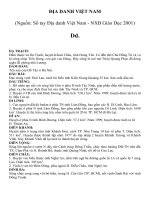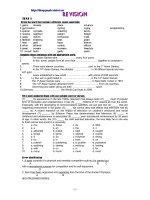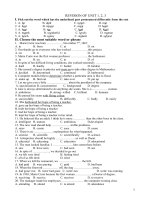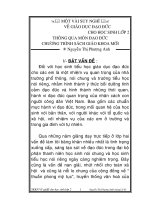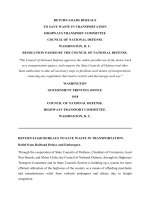Defect engineering of silicon based 2 d phononic crystals
Bạn đang xem bản rút gọn của tài liệu. Xem và tải ngay bản đầy đủ của tài liệu tại đây (7.49 MB, 227 trang )
DEFECT ENGINEERING OF SILICON
BASED TWO-DIMENSIONAL
PHONONIC CRYSTALS
WANG NAN
(B.Eng. (Hons.), NUS)
A THESIS SUBMITTED
FOR THE DEGREE OF DOCTOR OF PHILOSOPHY
DEPARTMENT OF
ELECTRICAL AND COMPUTER ENGINEERING
NATIONAL UNIVERSITY OF SINGAPORE
2013
i
DECLARATION
I hereby declare that this thesis is my original work and it has been written by
me in its entirety. I have duly acknowledged all the sources of information
which have been used in the thesis.
This thesis has also not been submitted for any degree in any university
previously.
Wang Nan
July 7, 2013
ii
ACKNOWLEDGEMENTS
With the completion of this thesis, a wonderful four-year journey has come to
an end, with a lot of fond memories left behind. I would like to express my
sincere gratitude to the following people who have helped me during this
four-year journey.
Firstly, I would like to thank my thesis advisors, Prof. Lee Chengkuo, Prof.
Moorthi Palaniapan and Prof. Kwong Dim-Lee. My greatest thanks go to Prof.
Lee Chengkuo, my main advisor, for his patience and valued guidance
throughout my research. He has graciously given some of his valuable time up
for consultation and discussion, to impart his knowledge and valuable insight
towards the progress of my research work. He has also provided many
valuable references and research tips which have helped me immensely. This
thesis would never be possible without his guidance and support. Many thanks
also go to my co-advisors, Dr. Moorthi Palaniapan and Prof. Kwong Dim-Lee,
for their continuous support in the completion of my Ph.D. research work.
Special thanks go to Prof. Hsiao Fu-Li, for inspiring me to enter the world of
phononic crystals with his knowledge on the fundamental theory, for his
valuable help on various numerical calculations and modelling, and for his
iii
suggestions and discussions when replying to the reviewers‟ comments during
the journal manuscript submission process.
Special thanks also go to Dr. Tsai Ming-Lin, for his help, discussions and
guidance on various complicated microfabrication processes.
I would like to express my deep thanks and appreciation to Mr. Soon Bo
Woon, for his time and help on the microfabrication of the batches of devices
reported in this thesis. The days and nights we spent together in the
cleanrooms will be an everlasting part of my memory.
I would also like to acknowledge the fabrication support from the Institute of
Microelectronics (IME), A*STAR, Singapore and the help from all my dear
group mates from the Centre for Integrated Circuit Failure Analysis and
Reliability (CICFAR), NUS, as well as people who helped me in one way or
another.
Last but not least, my special thanks go to my family: my loving parents and
wife, who have always been supporting me during the entire course of my
four-year journey.
iv
CONTENTS
DECLARATION i
ACKNOWLEDGEMENTS ii
CONTENTS iv
SUMMARY ix
LIST OF TABLES xii
LIST OF FIGURES xiii
LIST OF SYMBOLS AND ABBREVIATIONS xxvi
CHAPTER 1: INTRODUCTION 1
1.1 General introduction 1
1.2 Theoretical background 3
1.2.1 The Bravais Lattice and the unit cell 3
1.2.2 The Reciprocal Lattice and Brillouin Zone 4
1.2.3 Bloch theorem and the energy band theory 5
1.3 Literature review 9
1.3.1 PnC with different material compositions 9
1.3.1.1 Solid inclusions in solid background 9
1.3.1.2 Air inclusions in solid background 11
1.3.1.3 Vertical pillars on top of a substrate 13
1.3.2 PnC with different geometry 14
1.3.2.1 3-D PnC substrate 15
1.3.2.2 2-D PnC slab 17
v
1.3.2.3 1-D PnC strip 17
1.3.3 Applications of various PnC devices with defects introduced 18
1.3.3.1 Waveguides 18
1.3.3.2 Resonators 20
1.4 Motivation and objective 21
1.5 Organization of thesis 23
CHAPTER 2: METHODS FOR NUMERICAL CALCULATION28
2.1 Introduction 28
2.2 Introduction on finite-element-method (FEM) modelling
techniques 29
2.3 Numerical methods of pure PnC band gap calculation using
COMSOL Multiphysics software 31
2.3.1 Governing equations 31
2.3.2 Subdomain settings 33
2.3.3 Boundary conditions 36
2.3.4 Meshing and equation solving 37
2.4 2-D PnC slab band gap optimization 38
2.5 Numerical methods for modelling defected PnC using COMSOL
Multiphysics software 40
2.5.1 Calculation of the defected band structure of the PnC resonator
with linear defects introduced in an otherwise perfect PnC 44
2.5.2 Calculation of the transmission spectra of the PnC resonator
with linear defects introduced in an otherwise perfect PnC 47
2.5.3 Calculation of the steady-state displacement profiles of the PnC
resonator with linear defects introduced in an otherwise perfect PnC 50
2.6 Conclusions 53
vi
CHAPTER 3: MICROFABRICATION PROCESS AND
TESTING SETUP 55
3.1 Introduction 55
3.2 Detailed fabrication steps for devices in current work 56
3.2.1 AlN deposition and patterning 58
3.2.2 Top Al electrode deposition and patterning 61
3.2.3 PnC structure formation by DRIE through the silicon device
layer 62
3.2.4 Backside release by DRIE of silicon substrate and RIE of the
BOX layer 64
3.3 Processing outcome 66
3.4 Testing setup and procedure 74
3.5 Conclusions 79
CHAPTER 4: PHONONIC CRYSTAL WITH FABRY-PEROT
TYPE OF DEFECTS 81
4.1 Introduction 81
4.2 Design approach 85
4.3 SEM images of the microfabricated cavity-mode PnC resonator
based on Fabry-Perot types of defects 86
4.4 Testing results 88
4.5 Numerical simulations and discussions 91
4.6 Conclusions 96
4.7 Discussions on improved designs 97
vii
CHAPTER 5: PHONONIC CRYSTAL WITH
CENTRAL-HOLE DEFECTS 101
5.1 Introduction 101
5.2 Design approach 102
5.3 SEM images of the fabricated PnC with central-hole defects 105
5.4 Testing results 107
5.5 Numerical simulations and discussions 112
5.6 Conclusions 121
CHAPTER 6: PHONONIC CRYSTAL WITH DEFECTS OF
REDUCED CENTRAL-HOLE RADII 122
6.1 Introduction 122
6.2 Design approach 124
6.3 SEM images of the fabricated PnC with defects of reduced
central-hole radii 127
6.4 Testing results 129
6.5 Numerical simulations and discussions 136
6.5.1 Calculation of the defected band structure 136
6.5.2 Calculation of steady-state displacement profiles 143
6.6 Conclusions 149
CHAPTER 7: PHONONIC CRYSTAL WITH
ALTERNATE-HOLE DEFECTS 151
7.1 Introduction 151
viii
7.2 Design approach 153
7.3 SEM images of the fabricated PnC with defects of reduced
central-hole radii 157
7.4 Testing results 158
7.5 Numerical simulations and discussions 164
7.6 Conclusions 176
CHAPTER 8: CONCLUSIONS AND FUTURE WORK 178
8.1 Conclusions on current work 178
8.2 Recommendations for future work 181
BIBLIOGRAPHY 183
LIST OF PUBLICATIONS 194
ix
SUMMARY
The propagation of acoustic waves or elastic waves in phononic crystals
(PnCs) has been extensively studied during the past two decades. PnCs are the
acoustic wave equivalent of the well-known photonic crystals (PhCs),
whereby the propagation of acoustic waves which falls into a certain
frequency range (acoustic band gap) are completely forbidden in the PnC
structure, which consists of a PnC lattice formed by a periodic array of
scattering inclusions located in a homogeneous background material.
Moreover, by strategically engineering defects through removal or distortion
of the scattering inclusions on an otherwise perfect PnC material, devices of
different functionalities like resonators and waveguides can also be realised.
However, up to date, the defect engineering on an otherwise perfect PnC to
form resonators is mostly focused on the line defects in the form of
Fabry-Perot resonant cavities, in which the line defects are engineered by
completely removing several rows of the scattering air holes at the centre of
the PnC and in the directions perpendicular to the direction of wave
propagation. In this type of resonators, the performance in terms of the Q
factors and the insertion loss cannot be good, due to the significant mismatch
x
in the acoustic impedance of the central defected region and the surrounding
PnC region.
In this thesis, we aim to overcome the challenge faced by PnC resonators of
Fabry-Perot defects by reducing the mismatch of acoustic impedance through
partially modifying the scattering air holes instead of a complete removal.
Before engineering the partially modified scattering air holes, we first vary the
length of the cavity of the PnC resonators with Fabry-Perot defects, which is
the number of rows of scattering air holes being removed from the centre of
the PnC region, to study the effect of the cavity length on the performance of
the PnC resonators. Then, we investigate other types of defects engineered by
partially modified scattering air holes. Specifically, we design and fabricate
three types of PnC resonators based on partially modified scattering air holes,
i.e., resonators with central-hole defects, defects of reduced central-hole radii,
as well as alternate-hole defects. In addition to reducing the mismatch of
acoustic impedance, the latter two types of defects are also aimed to further
enhance the resonators‟ performance by reducing the energy leakage along the
lateral direction of the resonant cavity, with the help of the slow sound effect
existed in these two types of defects.
All the design processes are done by self-developed FEM methods using
xi
commercial software to calculate the band structure, the transmission spectra,
as well as the steady-state displacement profiles of the resonators. The devices
are realised by a customized fabrication process. Besides enhancing the
resonators‟ performance, the testing results also show that the PnC resonators
with properly engineered defects can be a potential candidate to overcome the
trade-off existed in conventional capacitive-based and piezoelectric-based
devices: the trade-off between the Q factor and the insertion loss,
demonstrating promising acoustic characteristics to be further optimized for
applications in RF communications.
xii
LIST OF TABLES
Table 4-1: Performance parameters of various cavity-mode resonators with
different cavity lengths 91
Table 5-1: Performance parameters of phononic crystal with central-hole
defects of different cavity lengths (L) and central-hole radii (r’) 111
Table 6-1: Performance parameters of phononic crystal with defects of
reduced central-hole radii of different cavity lengths (L) and central-hole
radii (r’) 134
Table 7-1: Performance parameters of PnC resonator with alternate-hole
defects of different cavity lengths (L) and central-hole radii (r’) 162
xiii
LIST OF FIGURES
Figure 1.1: (a) SEM image of a fabricated PnC structure with solid
inclusions in solid background. (b) Theoretically predicted (solid line) and
experimentally measured (dotted line) transmission data of a PnC reported in
[5]. This figure is reproduced from [5]. 10
Figure 1.2:(a) SEM image of the top view of the fabricated PnC device
reported in [7] with the hexagonal PnC lattice structure located in the centre
of the device and the transducer electrodes located on the two sides and (b)
cross sectional view of the device. This figure is reproduced from [7]. 12
Figure 1.3: Experimentally measured transmission data of the fabricated PnC
structure shown in Figure 1.2. This figure is reproduced from [7]. 12
Figure 1.4: Schematic drawing of a PnC device reported in [39], which is
made of an array of finite cylinders arranged in a square lattice and deposited
on top of a regular plate. This figure is reproduced from [39]. 14
Figure 1.5: SEM image of a PnC of square lattice reported in [4] formed by
embedding air inclusions in a lithium niobate substrate. This figure is
reproduced from [4]. 15
Figure 1.6: Experimentally measured transmission data of the reference
devices (dotted line) and the PnC devices (solid line) reported in [4]. The top
figure shows the transmission along ΓM direction, whereas the bottom figure
shows the transmission along ΓY direction. This figure is reproduced from
[4]. 16
Figure 1.7: Numerically simulated transmission coefficient in the unit of dB
xiv
of the 1-D PnC strip reported in [72]. The schematic drawing of the designed
1-D PnC strip is depicted in the inset. This figure is reproduced from [72]. 17
Figure 1.8: (a) pure PnC structure without any defect in [25] with integrated
AlN electro-acoustic couplers. (b)PnC based waveguides formed by
removing one row of scattering W rods along the horizontal direction from
the perfect PnC structure as shown in (a). Acoustic waves travel along the
horizontal direction of the device. This figure is reproduced from [25]. 18
Figure 1.9: Measured transmission spectra of the fabricated devices reported
in [25]. The blue line, the red line, and the green line represent the
transmission spectra of the pure background matrix without any PnC
structure, the PnC structure without any defects and the waveguide structure,
respectively. This figure is reproduced from [25]. 19
Figure 1.10: (a) Schematic drawing of the PnC resonator structure reported
in [94]. (b) SEM image of the top view of a fabricated PnC resonator formed
by completely removing air holes at the centre of the PnC region. This figure
is reproduced from [94]. 20
Figure 1.11: Normalized transmission spectra of the PnC resonator structure
for the (a) first, (b) second mode for the structure with three periods (12
rows) of scattering air holes on each side of the cavity, (c) first, and (d)
second mode for the structure with only two periods (eight rows) of
scattering air holes on each side of the cavity. This figure is reproduced from
[94]. 20
Figure 2.1: (a) Schematic drawing of the unit cell of the structure for band
gap calculation. The ideal PnC structure can be considered as an infinite
repetition of the unit cell along x and y directions, when periodic boundary
xv
conditions are applied along these two directions. (b) Schematic drawing of
the first Brillouin zone. Shaded area indicates the irreducible part of the first
Brillouin zone. (c) The band structure of the phononic crystal structure with
d=10μm, r=8μm and a=18μm, which gives r/a=0.45 and d/a=0.55. (d)-(h):
mode shapes of the first six modes as labelled in Figure 2.1(c). 35
Figure 2.2: Band gap optimization by (a) keeping d/a=0.5 and varying r/a (b)
keeping r/a=0.475 and varying d/a. d is fixed at 10μm for both cases. 39
Figure 2.3: (a) Schematic drawing of a typical PnC resonator with linear
defects introduced along y direction at the centre of the PnC region. (b) A
supercell of the typical PnC resonator which includes the introduced defects
and is used in the numerical calculation. It simulates the ideal PnC resonator
which is formed by an infinite repetition of the supercell when periodic
boundary conditions are applied along y direction (on the two faces which
are parallel to the x-z plane). Acoustic waves travel along x direction in
numerical modelling and in actual microfabricated devices. 42
Figure 2.4: An example of the band structure of the PnC resonator with
linear defects. It can be easily seen that the original band gap which exists in
Figure 2.1 (c) disappeared 46
Figure 2.5: An example of the steady-state displacement profiles. The u
x
, u
y
and u
z
represent the displacement vector components in x, y, and z directions,
respectively. The colour bar indicates the amplitude of displacements in an
arbitrary unit, with extreme red represents the maximum displacement
(maximum displacement amplitude in positive direction) and extreme blue
represents the minimum displacement (maximum displacement amplitude in
negative direction). 52
xvi
Figure 3.1: The schematic drawing (not to scale) of a typical PnC resonator
structure with linear defects introduced after all the fabrication process. Inter
digital transducers (IDTs) are formed on the two sides of the phononic
structure and the device is formed on a free-standing membrane, which is
released from the underlying silicon substrate. 56
Figure 3.2: Microfabrication process flow (not drawn to scale) starting from
SOI wafer: (i) AlN deposition and patterning (ii) Top Al electrode deposition
and patterning (iii) Phononic crystal formation by DRIE through the silicon
device layer (iv) Back side release by DRIE of the silicon substrate handle
layer and RIE of the BOX layer. 58
Figure 3.3: SEM image of the perfect PnC structure with air holes in a
silicon background. Inter digital transducers (IDTs) are formed by the
piezoelectric AlN layer and the Al IDT electrodes on the two sides of the
phononic structure. The scale bar represents 100µm. 66
Figure 3.4: Close-up view of the central phononic region with air holes
drilled in a silicon background. The scale bar represents 10 µm. The design
diameter of the air holes is 16µm. The deviation of fabricated value from the
designed is mainly due to the drift during the fabrication process. 67
Figure 3.5: More zoom-in view of the air holes after the silicon device layer
DRIE process, in order to examine the effects of over etching and micro
loading 69
Figure 3.6: Surface profiles measured by Veeco Wyko Non-contact
Profilometer for (a) the free-standing silicon slab without any PnC structure
(b) the optimized PnC structure. 72
xvii
Figure 3.7: Picture of the testing setup, including a calibrated vector network
analyser (VNA), which generate and detect AC signal, and a probe station,
which provides electrical interface between the VNA and the IDTs, along
with the low impedance RF cables. 75
Figure 3.8: Measured transmission spectra of the free-standing silicon slab
without any PnC structure. 77
Figure 3.9: Measured transmission spectra of the optimized perfect PnC
structure 77
Figure 4.1: Fabry-Perot etalon. The image is reproduced from reference
[111]. 82
Figure 4.2: Schematic drawing (Top view) of the supercell of the PnC
resonators with Fabry-Perot type of defects introduced of (a) L=2a (b) L=3a
(c) L=4a. Elastic waves travel along x direction. L represents the length of
the cavity, which means the number of rows of air holes being removed. The
grey regions represent silicon background and the white circles represent air
holes. The supercells repeat themselves in y direction in the microfabricated
devices and the acoustic waves travel along x direction. 85
Figure 4.3: SEM images (Top view) of cavity-mode PnC resonators with
Fabry-Perot type of defects introduced of (a) L=2a (b) L=3a (c) L=4a. Elastic
waves travel along x direction due to the piezoelectric effect. The scale bar in
each of the SEM image represents 100μm. Areas in solid square represents
supercells for FEM. Areas in dashed squares are the region to be zoomed in
and the close-up views are shown in Figure 4.4. 86
Figure 4.4: Close-up views (Top view) of the central defected regions of the
xviii
cavity-mode PnC resonators with Fabry-Perot type of defects introduced of
(a) L=2a (b) L=3a (c) L=4a. The scale bar in each of the SEM image
represents 20μm. 88
Figure 4.5: Measured transmission spectra of the cavity-mode PnC
resonators with Fabry-Perot type of defects introduced of (a) L=2a (b) L=3a
(c) L=4a. 89
Figure 4.6: Simulated transmission spectra of the cavity-mode PnC
resonators with Fabry-Perot type of defects introduced of (a) L=2a (b) L=3a
(c) L=4a. 92
Figure 4.7: Steady-state displacement profiles of the cavity-mode PnC
resonators with Fabry-Perot type of defects introduced of (a) L=2a (b) L=3a
(c) L=4a. 94
Figure 5.1: Schematic drawings (Top view) of the supercells of the PnC
resonators of L=2a with central-hole defects with radii (r’), (a) r’=2μm, (b)
r’=4μm, (c) r’=6μm, and (d) r’=8μm. L represents the length of the cavity,
which means the number of rows of air holes being removed. r’ represents
the radii of the air holes in the central defect region. The grey regions
represent silicon background and the white circles represent air holes. The
supercells repeat themselves in y direction in the microfabricated devices and
the acoustic waves travel along x direction. 102
Figure 5.2: Schematic drawings (Top view) of the supercells of the PnC
resonators of L=3a with central-hole defects with radii (r’), (a) r’=2μm, (b)
r’=4μm, (c) r’=6μm, and (d) r’=8μm. L represents the length of the cavity,
which means the number of rows of air holes being removed. r’ represents
the radii of the air holes in the central defect region. The grey regions
xix
represent silicon background and the white circles represent air holes. The
supercells repeat themselves in y direction in the microfabricated devices and
the acoustic waves travel along x direction. 103
Figure 5.3: SEM images (Top view) of the PnC structure with central-hole
defects and with different L and r’. (a) L = 2a and r’ = 4μm, and (b) L = 3a
and r’ = 2μm. L represents the length of the cavity, which means the number
of rows of air holes being removed. r’ represents the radii of the central air
holes in the silicon background. IDTs, which are formed by Al electrodes
and piezoelectric AlN layer, are on the two sides of the PnC region,
responsible of launching and detecting acoustic waves along x direction. The
area enclosed by solid red square represents the supercell which is used for
later FEM calculation. For each sub-figure, the picture on the left is the SEM
image of the entire structure and the picture on the right is the close-up view
of the central-hole region as enclosed by the dashed squares. For each L, four
different values of r’, i.e., r’=2μm, r’=4μm, r’=6μm, and r’=8μm are
included in the study but only two devices, one from each group of L, are
shown here for simplicity and illustration purpose. 105
Figure 5.4: Measured transmission spectra of the PnC structure with
central-hole defects and with L = 2a and different r’. (a) r’=2μm, (b)
r’=4μm, (c) r’=6μm, and (d) r’=8μm. 107
Figure 5.5: Measured transmission spectra of the PnC structure with
central-hole defects and with L = 3a and different r’. (a) r’=2μm, (b)
r’=4μm, (c) r’=6μm, and (d) r’=8μm. 109
Figure 5.6: Simulated steady-state displacement profiles of the PnC structure
with central-hole defects and with L = 2a and different r’, under their
xx
respective resonant frequencies. (a) r’=2μm, (b) r’=4μm, (c) r’=6μm, and (d)
r’=8μm. The u
x
, u
y
and u
z
represent the displacement vector components in x,
y, and z directions, respectively. The colour bar indicates the amplitude of
displacements in an arbitrary unit. 113
Figure 5.7: Simulated steady-state displacement profiles of the PnC structure
with central-hole defects and with L = 3a and different r’, under their
respective resonant frequencies. (a) r’=2μm, (b) r’=4μm, (c) r’=6μm, and (d)
r’=8μm. The u
x
, u
y
and u
z
represent the displacement vector components in x,
y, and z directions, respectively. The colour bar indicates the amplitude of
displacements in an arbitrary unit. 114
Figure 6.1: (a) Schematic drawings (Top view) of the supercell of the PnC
resonators with Fabry-Perot type of defects introduced of L = 2a. (b) – (d)
Schematic drawings of the supercells of the PnC resonators of L=2a with
defects of various reduced central-hole radii (r’), (b) r’=2μm, (c) r’=4μm,
and (d) r’=6μm. L represents the length of the cavity, which means the
number of rows of air holes being removed. r’ represents the radii of the air
holes in the central defect region. The grey regions represent silicon
background and the white circles represent air holes. The supercells repeat
themselves in y direction in the microfabricated devices and the acoustic
waves travel along x direction. 124
Figure 6.2: (a) Schematic drawings (Top view) of the supercell of the PnC
resonators with Fabry-Perot type of defects introduced of L = 3a. (b) – (d)
Schematic drawings of the supercells of the PnC resonators of L = 3a with
defects of various reduced central-hole radii (r’), (b) r’=2μm, (c) r’=4μm,
and (d) r’=6μm. L represents the length of the cavity, which means the
number of rows of air holes being removed. r’ represents the radii of the air
xxi
holes in the central defect region. The grey regions represent silicon
background and the white circles represent air holes. The supercells repeat
themselves in y direction in the microfabricated devices and the acoustic
waves travel along x direction. 125
Figure 6.3: SEM images (Top view) of the air/silicon PnC structure with
defects of reduced central-hole radii and with different L and r’. (a) L = 2a
and r’ = 4μm, and (b) L = 3a and r’ = 4μm. IDTs, which are formed by Al
electrodes and piezoelectric AlN layer, are on the two sides of the PnC
region, responsible of launching and detecting acoustic waves along x
direction. The area enclosed by solid red square represents the supercell
which is used for later FEM calculation. Pictures on the left are SEM images
of the full structure and pictures on the right are the close-up view of the
central defected region as enclosed by the dashed squares. For each L, three
different values of r’, i.e., r’=2μm, r’=4μm, and r’=6μm are included in the
study but only two devices, one from each group of L, are shown here for
simplicity and illustration purpose. 127
Figure 6.4: Measured transmission spectra of the PnC structures with defects
of reduced central-hole radii and with L = 2a and different r’. (a) r’=2μm, (b)
r’=4μm, and (c) r’=6μm. 129
Figure 6.5: Measured transmission spectra of the PnC structures with defects
of reduced central-hole radii and with L = 3a and different r’. (a) r’=2μm, (b)
r’=4μm, and (c) r’=6μm. 132
Figure 6.6: Calculated band structures of the PnC resonators with L = 2a and
with defects of different reduced central-hole radii (r’): (a) r’=0μm, (b)
r’=2μm, (c) r’=4μm, and (d) r’=6μm. The bands which correspond to the
xxii
measured resonant peaks shown in Figure 4.5(a) and Figure 6.4 are labelled
with red arrows. 136
Figure 6.7: Calculated band structures of the PnC resonators with L = 3a and
with defects of different reduced central-hole radii (r’): (a) r’=0μm, (b)
r’=2μm, (c) r’=4μm, and (d) r’=6μm. The bands which correspond to the
measured resonant peaks shown in Figure 4.5(b) and Figure 6.5 are labelled
with blue arrows. 140
Figure 6.8: Simulated steady-state displacement profiles the PnC structures
with defects of reduced central-hole radii and with L = 2a and different r’.
(a) r’=2μm, (b) r’=4μm, and (c) r’=6μm. The u
x
, u
y
and u
z
represent the
displacement vector components in x, y, and z directions, respectively. The
colour bar indicates the amplitude of displacements in an arbitrary unit. 143
Figure 6.9: Simulated steady-state displacement profiles the PnC structures
with defects of reduced central-hole radii and with L = 3a and different r’.
(a) r’=2μm, (b) r’=4μm, and (c) r’=6μm. The u
x
, u
y
and u
z
represent the
displacement vector components in x, y, and z directions, respectively. The
colour bar indicates the amplitude of displacements in an arbitrary unit. 146
Figure 7.1: Schematic drawings (Top view) of the supercells of the PnC
resonators of L=2a with alternate-hole defects with radii (r’), (a) r’=2μm, (b)
r’=4μm, (c) r’=6μm, and (d) r’=8μm. L represents the length of the cavity,
which means the number of rows of air holes being removed. r’ represents
the radii of the air holes in the central defect region. The grey regions
represent silicon background and the white circles represent air holes. The
supercells repeat themselves in y direction in the microfabricated devices and
the acoustic waves travel along x direction. 153
xxiii
Figure 7.2: Schematic drawings (Top view) of the supercells of the PnC
resonators of L=3a with alternate-hole defects with radii (r’), (a) r’=2μm, (b)
r’=4μm, (c) r’=6μm, and (d) r’=8μm. L represents the length of the cavity,
which means the number of rows of air holes being removed. r’ represents
the radii of the air holes in the central defect region. The grey regions
represent silicon background and the white circles represent air holes. The
supercells repeat themselves in y direction in the microfabricated devices and
the acoustic waves travel along x direction. 154
Figure 7.3: Schematic drawings (Top view) of the supercells of the PnC
resonators of L=4a with alternate-hole defects with radii (r’), (a) r’=2μm, (b)
r’=4μm, (c) r’=6μm, and (d) r’=8μm. L represents the length of the cavity,
which means the number of rows of air holes being removed. r’ represents
the radii of the air holes in the central defect region. The grey regions
represent silicon background and the white circles represent air holes. The
supercells repeat themselves in y direction in the microfabricated devices and
the acoustic waves travel along x direction. 155
Figure 7.4: SEM images (Top view) of (a) the perfect PnC structure (b) the
PnC resonator with alternate-hole defects of L=2a and r’=4μm, (c) the PnC
resonator with alternate-hole defects of L=3a and r’=4μm, (d) the PnC
resonator with alternate-hole defects of L=4a and r’=4μm. L represents the
length of the cavity, which means the number of rows of air holes being
removed. r’ represents the radii of the alternate central air holes in the silicon
background. The insets of (b), (c) and (d) depict the close-up views of the
resonant cavities of the three cases, respectively. (e) Schematic drawing of
one of the designed devices. For each L, four different values of r’, i.e.,
r’=2μm, r’=4μm, r’=6μm, and r’=8μm are included in the study but only
xxiv
three devices, one from each group of L, are shown here for simplicity and
illustration purpose 157
Figure 7.5: Measured transmission spectrum the PnC resonator with
alternate-hole defects of L=2a and with (a) r’=2μm, (b) r’=4μm, (c) r’=6μm,
and (d) r’=8μm. The measured transmissions correspond to the cavity modes
of k
y
=0. 158
Figure 7.6: Measured transmission spectrum the PnC resonator with
alternate-hole defects of L=3a and with (a) r’=2μm, (b) r’=4μm, (c) r’=6μm,
and (d) r’=8μm. The measured transmissions correspond to the cavity modes
of k
y
=0. 159
Figure 7.7: Measured transmission spectrum the PnC resonator with
alternate-hole defects of L=4a and with (a) r’=2μm, (b) r’=4μm, (c) r’=6μm,
and (d) r’=8μm. The measured transmissions correspond to the cavity modes
of k
y
=0. 160
Figure 7.8: Calculated band structure of (a) the perfect PnC structure (b) of
the PnC resonator with alternate-hole defects of L=4a and with r’=8μm. 164
Figure 7.9: The band structure which corresponds to the resonant peak
(bottom figure), the first order derivative of frequency against wave vector
(middle figure), and the simulated transmission field distributions of the
displacement profile under the resonant frequency (top figure) of the PnC
resonator with alternate-hole defects of L=2a and with (a) r’=2μm (b)
r’=4μm (c) r’=6μm (d) r’=8μm. The simulated field distributions correspond
to the cavity modes of k
y
=0. The colour bar represents the amplitude and
sign of the displacement. 168


